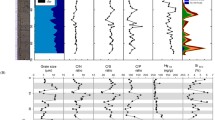Abstract
Monomictic Lake Kinneret is stratified during summer and autumn, resulting in a hypolimnion rich in H2S (3–7 mg 1−1). In winter and spring every year a bloom of dinoflagallate Peridinium gatunense produces an average biomass of 150000 ton wet weight. Part of this biomass sinks to the hypolimnion and sediments where it is decomposed and mineralized, with some of the mineralization due to the activity of sulfate-reducing bacteria (SRB). The sulfate-reduction potential of the upper sediment layer at the deepest part of the lake (42 m) was measured. The activity of the enzyme arylsulfatase was also monitored. Rates of sulfate-reduction ranged from a minimum of 12 nmoles SOf4 p2−-reduced cm−3 day−1 in December before lake overturn to a maximum of 1673 nmoles SOf4 p2− reduced cm−3 day−1 in July during stratification. These rates are considerably higher than those recorded from other freshwater lakes in the world and are probably limited more by the availability of organic matter than by sulfate concentrations.
Similar content being viewed by others
References
APHA, 1985. Standard Methods for examination of water and wastewater (16th edition). American Public Health Association, Washington, D.C.
Berman, T. & U. Pollingher, 1974. Annual and seasonal variations of phytoplankton, chlorophyll and photosynthesis in Lake Kinneret. Limnol. Oceanogr. 19: 31–54.
Canfield, D. E., 1989. Sulphate reduction and oxic respiration in marine sediments. Implications for organic carbon preservation in anoxic environments. Deep Sea Res. 36: 121–138.
Capone, D. G. & R. P. Kiene, 1988. Comparison of microbial dynamics in marine and freshwater sediments: Contrasts in anaerobic carbon catabolism. Limnol. Oceanogr. 33: 725–749.
Cooper, P. J. M., 1972. Arylsulfatase activity in northern Nigerian soils. Soil Biol. Biochem. 4: 333–337.
Dunnette, D. A., 1989. Origin of hydrogen sulfide in freshwater sediments in biogenic sulfur in the environment. ACS Symposium Series, 393: 72–78.
Hordijk, K. A., C. P. M. Hagenaars & T. E. Cappenberg, 1985. Kinetic studies of bacterial sulfate-reduction in freshwater sediments by high pressure liquid chromatography and microdistillation. Appl. envir. Microbiol. 49: 434–440.
Ingvorsen, K. & B. B. Jorgensen, 1984. Kinetics of sulfate uptake by freshwater and marine species of Desulfovibrio. Arch. Microbiol. 132: 61–66.
Ingvorsen, K., J. G. Zeikus & T. D. Brock, 1981. Dynamics of bacterial sulfate-reduction in a eutrophic lake. Appl. envir. Microbiol. 42: 1029–1036.
Jarvis, B. W. & G. E. Lang, 1987. Arylsulfatase activity in peat exposed to acid precipitation. Soil Biol. Biochem. 19: 107–109.
Jorgensen, B. B., 1977. The sulfur cycle of a coastal marine sediment (Limfjorden, Denmark). Limnol. Oceanogr. 22: 814–832.
Jorgensen, B. B., 1978. A comparison of methods for the quantification of bacterial sulfate-reduction in coastal marine sediments. Geomicrobiol. J. 1: 11–27.
King, G. M., 1988. Patterns of sulfate-reduction and the sulfur cycle in a South Carolina salt marsh. Limnol. Oceanogr. 33: 376–390.
King, G. M. & M. J. Klug, 1980. Sulphydrolase activity in sediments of Wintergreen Lake, Kalamazo County, Michigan. Appl. envir. Microbiol. 39: 950–956.
King, G. M. & M. J. Klug, 1982. Comparative aspects 35SOf4 p2− of sulfur mineralization in sediments of eutrophic lake basin. Appl. envir. Microbiol. 43: 1406–1412.
Landers, D. H. & M. J. Mitchell, 1988. Incorporation of 35SOf4 p2− into sediments of three New York lakes. Hydrobiol. 160: 85–95.
Mazor, B., 1978. Mineral waters of the Kinneret Basin and possible origin. In: C. Serruya (ed.), Lake Kinneret Monographiae. Dr W. Junk Publishers, The Hague.
Serruya, C. (ed.), 1978. Lake Kinneret Monographiae. Dr W. Junk Publishers, The Hague. 502 pp.
Serruya, C., 1980. Chemical processes. In: Limnological Processes in Lake Kinneret During 1969–1979. Summary Report (in Hebrew), 7–17.
Serruya, C., M. Edelstein, U. Pollingher & S. Serruya, 1974. Lake Kinneret sediments: Nutrient composition of the pore water and mud water exchanges. Limnol. Oceanogr. 19: 489–508.
Skyring. G. W., 1987. Sulphate reduction in coastal ecosystems. Geomicrobiol. J. 5: 295–374.
Smith, R. L. & M.J. Klug, 1981a. Reduction of sulfur compounds in the sediments of a eutrophic lake basin. Appl. envir. Microbiol. 41: 1230–1237.
Smith, R. L. & M. J. Klug, 1981b. Electron donors utilized by sulfate reducing bacteria in eutrophic lake sediments. Appl. envir. Microbiol. 42: 116–121.
Staudinger, B., 1989. Seasonal variation of the phosphorus mobility in the porewater of sediments of Lake Kinneret. MSc thesis, University of Bayreuth, Germany.
Stiller, M., 1974. Rates of transport and sedimentation in Lake Kinneret. Ph.D. thesis, Feinberg Graduate School, The Weiman Institute, 1974. 240 pp.
Tabatabai, N. A. & J. A. Bremner, 1970. Arylsulfatase activity in soils. Soil Sci. Soc. Amer. Proc. 34: 225–229.
Tessenow, U., T. Frevert, W. Hofgastner & A. Moser, 1977. Ein simultan schliesender serienwasserschopfer fur sedimentkontaktwasser mit fotoelktrischer selbstauslosung und fakultativem sedimentstecher. Arch. Hydrobiol. suppl. 48: 438–452.
Westerman, B. S. & B. K. Ahring, 1987. Dynamics of methane production, sulfate-reduction and dentifrification in a permanently waterlogged Alder swamp. Appl. envir. Microbial. 53: 2554–2559.
Westrich, J. T. & R. A. Berner, 1984. The role of sedimentary organic matter in bacterial sulfate-reduction: the G model tested. Limnol. Oceanogr. 29: 236–249.
Westrich, J. T. & R. A. Berner, 1988. The effect of temperature on rates of sulfate-reduction in marine sediments. Geomicrobiol. J. 6: 99–117.
Author information
Authors and Affiliations
Rights and permissions
About this article
Cite this article
Hadas, O., Pinkas, R. Sulfte-reduction process in sediments of Lake Kinneret, Israel. Hydrobiologia 235, 295–301 (1992). https://doi.org/10.1007/BF00026221
Issue Date:
DOI: https://doi.org/10.1007/BF00026221




